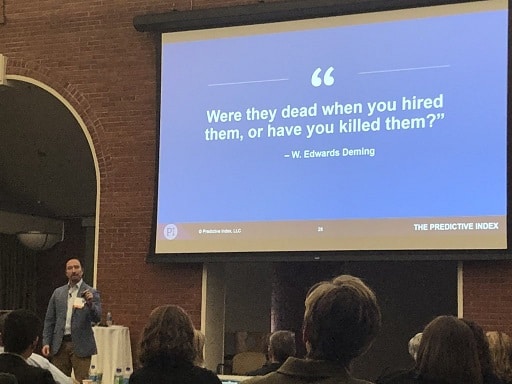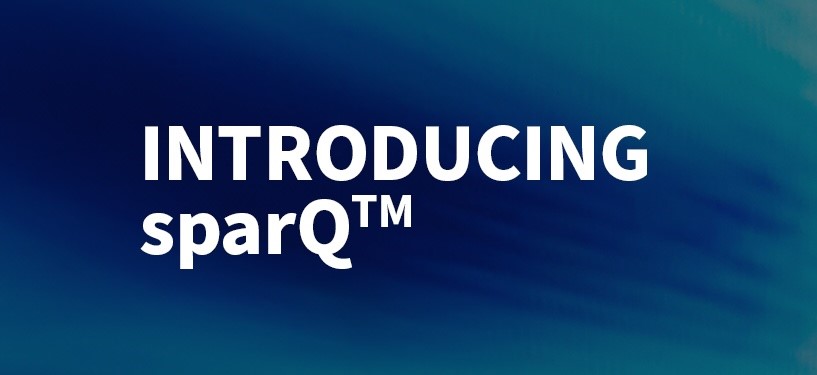Earlier this month, MassTLC hosted our first ever EmployeeXP Conference, a gathering of almost 300 professionals to discuss the critical topic of employee engagement in the modern workforce. It was a great event for all involved, full of useful insight and practical advice – but don’t take our word for it.
Ashley Ryall of UntapSocial has been kind enough to share her own personal recap of the day with us. Read on for an attendee’s perspective of EmployeeXP.
_____
5 Things I Learned from MassTLC’s “Revolutionizing EmployeeXP” Conference
Last Friday’s MassTLC #EmployeeXP conference at Bentley University was jam-packed with lessons from leading talent experts about how employers can think more strategically about hiring and developing current and future employees. The biggest lesson I took away from the conference was this: sure, we’re getting comfy in the age of “employee consumerization” and have been actively discussing that we need to treat employees with the same care and attention that we treat our customers. But the truth is, as I learned on Friday, it’s so much more than that. It’s as if this idea of “employee consumerization” has been in beta testing, and now we’re being called to roll it out full scale.
The bottom line? If we treat our employees as our number one priority, they’ll treat our customers as their number one priority.
Many of the biggest names headquartered in Massachusetts – iRobot, Crayon, Wayfair, Rapid7, Bullhorn and more – explained the business case for why we should invest as much time, effort, money and resources into our employees’ learning and development as we invest in our customers’ satisfaction. More organizations across industries and borders are privy to the talent war and are upping their game, competitively. So if you’re not actively working to solve this problem, “you’re falling behind,” says MassTLC president Tom Hopcroft.
Here are my five biggest takeaways from the conference:
- You can’t make the promise to your employees different than the promise you make to your customers.
This was the loudest plea across every session topic on Friday. SVP of HR at iRobot, Russ Campanello, walked us through iRobot’s identity rebrand, which married their military business with their consumer brand, and explained the impact of that transition on how he recognized employee culture. “Our consumer mission became our company mission,” which, for iRobot, is to empower people to do more. When consumer values and employee values are aligned and communicated the same way internally as they are externally, it begets a whole new way of looking at employee consumerization. “Employees being that close to the vibrancy of the customer changed everything [for us] and helped them become more responsive.”
- Apply an engineering mindset to employee learning and development.
Jim Page, Director, People Development at Rapid7, and his team showed us how we can transform employees’ career and learning experiences by designing experience journey maps with the help of our UX engineers. Just as we can map the different touchpoints of a customer’s experience, so too can we for an employee’s experience, whether they are a new hire, manager, non-manager or leader.

Rapid7 talent leaders taught us how we can provide the right learning to the right employee at the right time by taking the following steps: 1] conduct a needs analysis for whatever content you’re delivering, using a range of modalities like email, Slack, and surveys, because not all employees process information the same way; 2] change existing employee programs and implement new ones; 3] collect and evaluate data all the time through continuous feedback loops and 4] map all of that data in experience maps.
For example, for a new hire’s first day, map out all the touchpoints she will encounter. How will you make her aware of the new hire program and what modalities will you use? What all will she be doing and experiencing on her first day? Put your empathy hat on – what emotions might she be feeling with each touchpoint (overwhelm, nervousness, confusion, optimism)? What might she be thinking after her benefits training and what evidence will you have to support your predictions? [see worksheet below:]
This session gave me a handful of practical applications for fostering a company culture of continuous learners.

- Rethink how you’re sourcing and hiring talent.
With Massachusetts harboring one of the most competitive talent markets, a creative approach towards attracting the right talent is the only way to win. Don’t be afraid to lean on organizations like reacHire, Tech Connection, CyberWarrior Academy, ScholarJet, Resilient Coders and Boston Private Industry Council [PIC], all of which provide employer access to diverse talent pools.
During the session, Outside the Box Thinking to Scale Your Talent Pool, Tech Connection Founder & CEO Melissa James challenged the audience to throw out the word “culture fit” and instead hire candidates based on “values fit.” There’s this implication that candidates need to be like us – whoever we think we are as a culture – which is a dangerous play. “Let’s not cap our culture and instead interview candidates based on what they stand for.”
So how can employers identify candidate traits during an interview who are a “culture add” to their organization’s success? The answer is to look for transferable skills. For example, Joanne Domeniconi, Co-Founder of The Grommet, shared her reason for hiring a pastry chef as her operations manager. “The Grommet operates a lot like a kitchen,” so Joanne took a risk on someone who had no experience in e-commerce or media but was an operational wizard.

- How can you define and then operationalize your company values? Ask your children.
Michelle Roccia, EVP of Employee Engagement at WinterWyman and Bob Quinn, Chief People Officer at Cygilant, drove home the point of keeping your company values simple and founded on kindergarten principles like the Golden Rule. Mock up a list and then ask your children if they can understand it. Values that are simple and straightforward are easier to implement and reinforce. Bob suggested we rely on an old proverb when it comes to sewing corporate values into the fabric of your organization. “The best way to learn is to teach. Involve brand champions into values communication and recognition so your staff start to believe them internally and make them their own.”
So what do you do when someone isn’t living in accordance to the values you set forth? Michelle said it’s a cancer internally and will eventually catch up with you. “What you build inside will reflect outside. At WinterWyman, if we don’t have our integrity, we have nothing,” she says.
Chief People Officer at Bullhorn, Kim Castelda, agreed. When asked by an audience member how employers can sustain core values and keep them alive after the initial hype wears off, Kim replied that reinforcement from the top down is necessary. “In order to bring our values to life, we had to explain what ‘ownership’ looked like and use our weekly town hall meetings for leaders to publicly recognize employees who demonstrated a core value.”
- Be aware of the highly curated interview process and its ability to skew the hiring process.
Mike Zani, CEO of Predictive Index [PI] reminds us that observed behaviors are complex, especially during the interview. In other words, you’re not going to pick up on potential risks or a candidate’s true motivators in an interview environment where answers have been practiced, specifically tailored and potentially fabricated. Instead, leaning on behavioral tools like the PI can help you get at exactly what you’re looking for in your next hire.
As the PI often suggests, two people can look at the same problem and think two completely different things. Similarly, when hiring for a salesperson, the Hunter and the Farmer both look like salespeople in an interview. The Hunter excels at generating a lot of leads quickly while The Farmer excels at growing existing business. The Farmer may be a champion at interviewing, but they don’t hunt like champions. Be careful not to hire a Farmer for a Hunter role and vice versa.
Just as a highly curated interview process can make for the wrong hire [and we’re all aware of how messy THAT can be], Erika Bonaparte and Shrina Sood of Curriculum Associates reminds us that, how we conduct our candidate experience directly translates to the employee’s experience once hired, in the breakout session, From Candidate to Contributor. (See their presentation here: From Candidate to Contributor.)
FINAL THOUGHTS
The highest performing companies treat people differently. And as Mike Zani and author and speaker, Glenn Elliott, both boldly claim in their keynote discussions – it’s not that employees aren’t engaged; organizations disengage them.
If we’re inflexible with offering flex work, ignore our employees’ inherent desire to grow and learn, aren’t transparent and upfront about why someone was fired or remain uneducated about how our compensation structure might be affecting begrudged employees, we’re not living up to our potential as a company.
When half of our staff is looking for a new job, and 70% of employees are disengaged at work, Glenn pleads for every employee, not just HR, to put their “people” hat on, saddle up, and work together to mind the “Engagement Gap” so, collectively, we can fundamentally change the working relationship we have with our people.

LINKS TO SESSION PRESENTATIONS
The Hiring Manager’s Guide to DIY Recruiting and Development
Go Team Go! The 5-Step Coaching Strategy to Build Thriving, High-Performing Teams
Help Your Organization Excel: Overcoming Unconscious Bias
Organizational Transformation from the Inside Out
Developing Your People: A Look at 4 Employee Audiences in 40 Minutes
MENTIONED RESOURCES
- Book, Build It: The Rebel Playbook for World-Class Employee Engagement by conference keynote Glenn Elliott
- Book, The Advantage by Patrick Lencioni on cohesive leadership teams and creating and sustaining clarity
- Predictive Index



